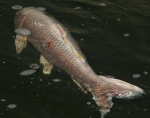Cyvirus, also known as Cyprinivirus is a genus of viruses in the order Herpesvirales, in the family Alloherpesviridae. Freshwater eels serve as natural hosts. There are four species in this genus. Diseases associated with this genus include: hemorrhagic disease.[1][2]
| Cyprinivirus | |
|---|---|

| |
| Virus classification | |
| (unranked): | Virus |
| Realm: | Duplodnaviria |
| Kingdom: | Heunggongvirae |
| Phylum: | Peploviricota |
| Class: | Herviviricetes |
| Order: | Herpesvirales |
| Family: | Alloherpesviridae |
| Genus: | Cyvirus |
| Species | |
|
See text | |
| Synonyms | |
| |
Species
editThe genus consists of the following four species:[2]
Structure
editViruses in Cyprinivirus are enveloped, with icosahedral and spherical to pleomorphic geometries, and T=16 symmetry. The diameter is around 200 nm. Genomes are linear and non-segmented, around 10kb in length. The genome codes for 136 proteins.[1]
| Genus | Structure | Symmetry | Capsid | Genomic arrangement | Genomic segmentation |
|---|---|---|---|---|---|
| Cyprinivirus | Spherical pleomorphic | T=16 | Enveloped | Linear | Monopartite |
Life cycle
editViral replication is nuclear, and is lysogenic. Entry into the host cell is achieved by attachment of the viral glycoproteins to host receptors, which mediates endocytosis. DNA-templated transcription is the method of transcription. Freshwater eel serve as the natural host. Transmission routes are passive diffusion.[1]
| Genus | Host details | Tissue tropism | Entry details | Release details | Replication site | Assembly site | Transmission |
|---|---|---|---|---|---|---|---|
| Cyprinivirus | Fresh water eel | None | Glycoprotiens | Budding | Cytoplasm | Cytoplasm | Passive diffusion |
References
edit- ^ a b c "Viral Zone". ExPASy. Archived from the original on 28 August 2015. Retrieved 13 August 2015.
- ^ a b "Virus Taxonomy: 2020 Release". International Committee on Taxonomy of Viruses (ICTV). March 2021. Retrieved 10 May 2021.
External links
edit